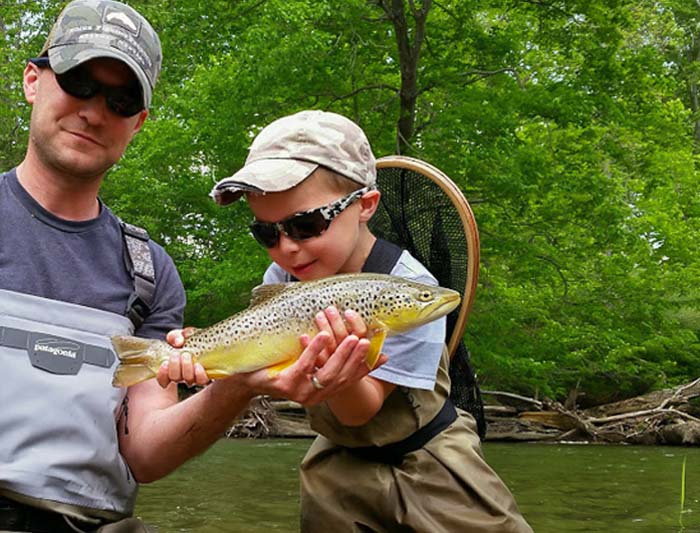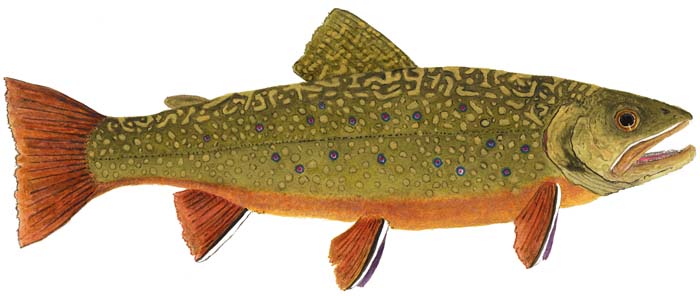
Troutbitten’s Domenick Swentosky – Life on the water . . . with one of his boys holding a nice Pennsylvania brown trout. Troutbitten photo.
Rethinking your streamer retrieves
By Skip Clement
[dropcap]T[/dropcap]here’s a great article by Troutbitten’s Domenick Swentosky titled The Endless Retrieve. It’s more heretical than the author lets on – casting upstream and then retrieving without hesitations natural to line gathering or never to jig the fly or make erratic its downhill return in any way. All done at speed slightly greater than the current.
I grew up fishing gear and bait, and I like to think I was pretty handy with the spinning rod. From elementary school through my late teens, small lures and bait (mostly fathead minnows) were my familiar tools for putting trout in the net and the frying pan. Once the spring crowds tapered off, my access to live minnows was limited, as the local bait shops stopped carrying them until next year. I didn’t live close enough to a healthy stream to make trapping my swimming bait a good option. So in early June, I turned to in-line spinners like Mepps, Panther Martins, and Rooster Tails. To a lesser extent, I also stocked a few smaller Rapalas in my worn out, tan fishing vest.
Mark (school friend) taught me to present the lures upstream. Throw a cast mostly up and sometimes slightly across the currents. Then reel and retrieve fast enough to keep the blade of the spinner turning — usually a little faster than the current. Mark also taught me to keep the spinner moving, never stop its progress downstream and only rarely change speeds. It was deadly.” — Domenick Swentosky
What Mark taught Swentosky chucking metal after school in Pennsylvania was from the world of nymphing, introduced to the universe in 1989 at the World Fly Fishing Championships held in Kuusamo, Finland. The story was as incendiary 30 years ago as Swentosky’s is today. And here’s how the technique for nymphing for trouts changed nymphing forever.
A member of the Polish fly fishing team, Vladyslaw “Vladi” Trzebunia, landed 60 fish – besting his next three closest competitor teams’ combined catches. He, of course, won the individual title and his Polish team took home the team title.

Vladi Trzebunia with a nice grayling (Thymallus thymallus).
In the following years, Vladi’s nymphing technique would be hijacked and renamed, imitated, and appropriated by the fly fishing world. You perhaps know the Polish nymphing technique by different names; tweaked to be reborn to “new fathers of new nationalities.”
Vladi Trzebunia took what he had learned from his father who developed the nymphing technique in the 30s, with meliorations of course, and applied them to fly fishing.
Vladi’s father’s technique worked best in fast water and water no deeper than the middle of his thighs. He also determined that tail-outs of pools, or just downstream from riffles were great feeding locations and fished well even if the water was a little off-color.
Here’s the Polish nymphing technique:
• The fly should be kept at the bottom of the run.
• The fish are attracted to the motion.
• The fly has to be pulled without hesitations.
• The fly is not jigged.
• The fly is not to be redirected.
• The fly needs to be pulled downstream at a slightly faster speed than the current.

Eastern brook trout. Image provided courtesy of Thom Glace.
In comparison, here’s Domenick’s steamer technique:
• The fish are attracted to the motion.
• The fly has to be pulled without hesitations.
• The fly is not to be redirected.
• The fly is not jigged.
• The fly needs to be drawn downstream at a slightly faster speed than the current.
• The fly is kept sub-surface

